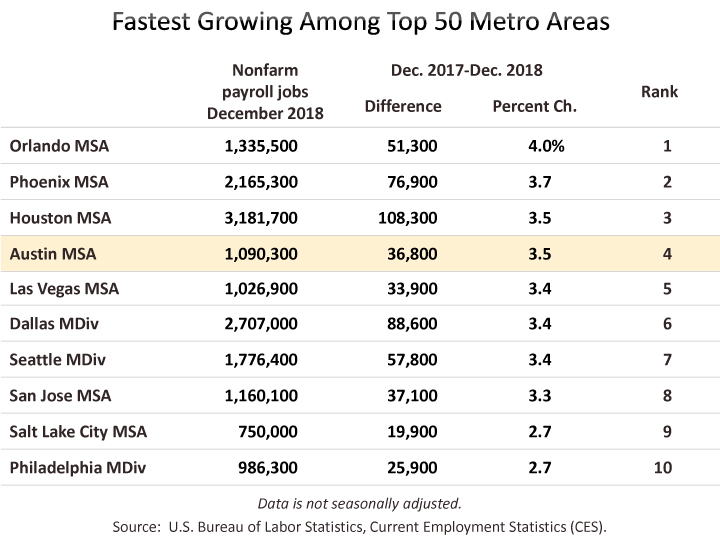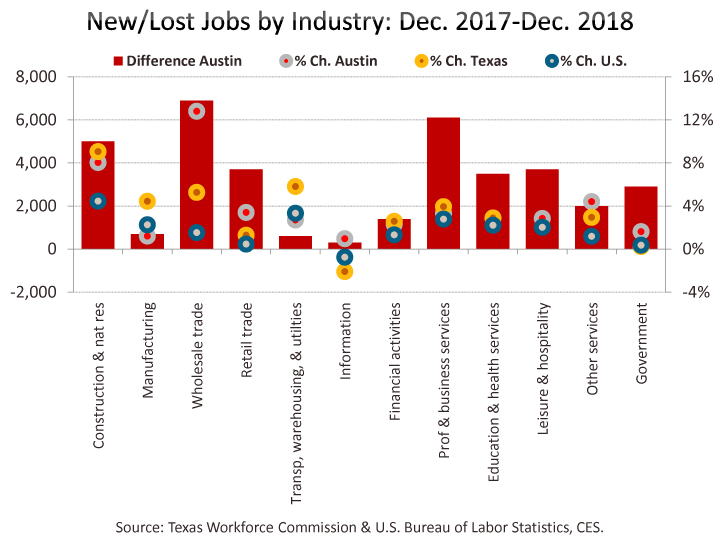Job Growth & Unemployment
Posted on 01/22/2019 by Beverly Kerr
- Austin added 36,800 net new jobs, growth of 3.5%, in the 12 months ending in December, making Austin the fourth fastest growing major metro.
- Wholesale trade was Austin’s fastest growing industry (12.8%) and it also added the most jobs (6,900) over the last 12 months.
- Austin's seasonally adjusted unemployment rate is 2.9%, up from 2.8% in November. Unemployment has been at or below 3.0% for the last 16 months.
The Austin metropolitan area added 36,800 net new jobs, or 3.5%, in the 12 months ending in December, according to Friday's releases of preliminary payroll jobs numbers by the Texas Workforce Commission (TWC) and the U.S. Bureau of Labor Statistics (BLS).

Austin’s 3.5% growth makes it the fourth best performing among the 50 largest metro areas. Houston and Dallas, up 3.5% and 3.4% respectively, also made the top ten. Fort Worth (up 2.7%) and San Antonio (up 0.8%) ranked 11th and 45th.

For the year ending in December, private sector growth in the Austin MSA is 3.9%, or 33,900 jobs, with all private industry divisions adding jobs. Austin's sizable government sector (over 17% of jobs) added 2,900 jobs or 1.6%, thus bringing the overall growth rate to 3.5%.

Texas saw net private sector job growth of 3.6% with all private industries, except information, adding jobs over the last 12 months. Total job growth was 3.1% as the government sector, which accounts for 16% of total state employment, was nearly unchanged (up 0.2%). For the nation, private sector growth is 2.0% for the 12 months ending in December with all private industries, except information, adding jobs. Overall job growth is a more modest 1.8% because of minor (0.4%) government sector growth.

Jobs in December are up from the preceding month by 3,200 jobs or 0.3% in the not-seasonally-adjusted series for Austin. In the seasonally adjusted series, growth is stronger, up by 4,800 jobs or 0.4%. Seasonally adjusted jobs are up by 0.7% in Fort Worth, 0.3% in Dallas, 0.1% in Houston, and down 0.2% in San Antonio. Statewide, seasonally adjusted jobs are up 38,000 or 0.3%. Nationally, seasonally adjusted jobs are also up 0.2% from November.

In Austin, the industry adding the most jobs and growing the fastest is wholesale trade which grew by 6,900 jobs or 12.8% over the last 12 months. Also growing at faster-than-average rates are construction and natural resources (8.1% or 5,000 jobs) and other services (4.4% or 2,000 jobs). Professional and business services growth was less than average at 3.3%, but it added 6,100 jobs (more than any industry except wholesale trade).

Statewide, construction and natural resources grew fastest (9.1%) and added the most jobs (87,100) over the last 12 months. The other relatively fast growing industries were transportation, warehousing, and utilities (5.8%); wholesale trade (up 5.3%); manufacturing (4.4%); and professional and business services (3.9%). Jobs declined in information by 2.1%.
Nationally, construction and natural resources grew fastest, adding 4.5% over the 12 months ending in December. Transportation, warehousing, and utilities (3.3%); professional and business services (2.8%); manufacturing (2.3%); and education and health services (2.2%) were also relatively fast growing. Information jobs fell by 0.8%.

The net gain for private service-providing industries in Austin is 28,200 jobs, or 3.7%, over the last 12 months. Employment in goods producing industries is up by 5,700 jobs or 4.8%. Statewide, private service-providing industries are up 253,000, or 2.9%, and goods producing industries are up 125,300 jobs, or 6.9%.
We also now have December labor force, employment, and unemployment numbers for Texas and local areas in Texas. The same data for all U.S. metros will not be released until January 30. In November, Austin had the sixth lowest rate of unemployment among the 50 largest metros.
Unemployment numbers for December show Austin’s performance relative to the state and other major Texas metros being sustained. In December, Austin is at 2.7%, while the other major metros range from 3.2% in Dallas and San Antonio to 3.9% in Houston. Fort Worth is at 3.3%. Austin’s rate one year ago was also 2.7%. The rate in Houston is improved from 4.3% a year ago, while the rates in Dallas, Fort Worth, and San Antonio are higher. The statewide not-seasonally-adjusted rate is now 3.6%, down from 3.7% in December of last year. The national unemployment rate is 3.7%, improved from 3.9% a year ago.

Within the Austin MSA, Travis County has the lowest unemployment rate in December, at 2.6%, while Caldwell County has the highest at 3.4%. The rate is 2.9% in Hays and Williamson Counties and 3.1% in Bastrop County.
On a seasonally adjusted basis, Austin’s December unemployment rate is 2.9%, up from 2.8% in November. The statewide seasonally adjusted rate is 3.7% in December, unchanged from November. The national rate is 3.9%, up from 3.7%.
Among Texas’ major metros, San Antonio has the next lowest seasonally adjusted rate at 3.4%, Dallas and Fort Worth are at 3.5%, and Houston is at 4.2%. Each metro’s rate is up from November. Seasonally adjusted unemployment rates for Texas metros are produced by the Federal Reserve Bank of Dallas. (The TWC also produces seasonally adjusted rates for Texas metros, but publication lags the Dallas Fed’s data.)

While Austin’s unemployment rate is unchanged from one year ago, the number unemployed has increased. In December 2017, Austin’s number of unemployed was 31,139. Over the last 12 months, the unemployed have increased by 1,836, or 5.9%, to 32,975. This is due to a larger increase in labor force, compared to employment. The Austin metro’s civilian labor force (employed plus unemployed) increased by 43,696 persons or 3.8% from one year ago, while persons employed increased by 41,860 or 3.7%.

Texas’ labor force growth was 2.8% and employment growth was 2.9%. However, the numeric change in labor force exceeded that of employed, therefore the number of unemployed increased by 2,813 or 0.6%. Nationally, December civilian labor force is up by 2.63 million or 1.6%, while employed is above the level of a year ago by 2.88 million or 1.9%, and 249,000 fewer people (4.0%) are unemployed.


The TWC and the BLS will release January estimates on March 8.
Related Categories: Central Texas Economy in Perspective